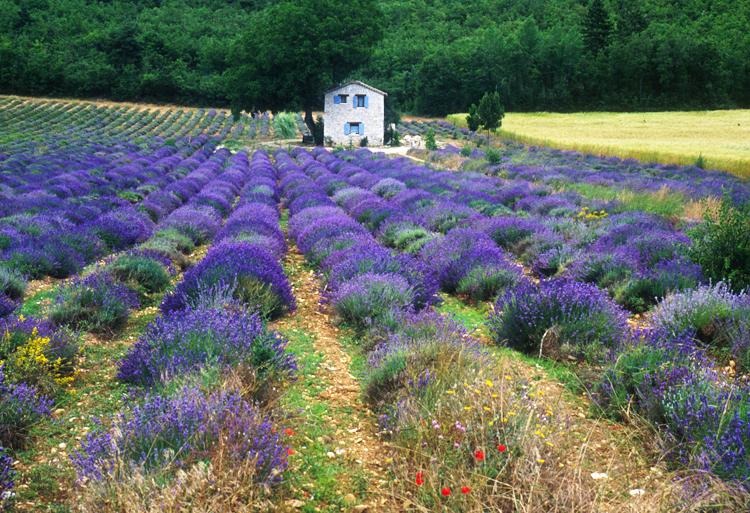One of the better known phenomena of the Thyme essential oils from Provence is summarized by the term “Chemotypes.” The most popular is probably so-called Thyme linalool. This is aromatherapy shorthand for essential oil of Thymus vulgaris, type linalool. It indicates that this particular oil contains a high concentration of the terpene alcohol linalool. Let’s take a look, the Thyme chemotypes from Provence are perfect to study essential oil authenticity.
The most important factor determining the actual composition of a Thyme oil is elevation. The higher we go the more the blue and ultraviolett components of visible light become stronger. And the composition of light influences the formation of essential oils directly as terpene synthesis begins in the chloroplast! In Provence, given its unique topography, growing areas at a 600 feet altitude can be only a few miles away from plateaux at 2400 feet or higher. The hot and possibly irritant, but also very strongly antibacterial phenolic Thyme (Thyme thymol) oils grow at sea level. A few miles away and at slightly higher elevation Thyme paracymene with its anti-rhumatism qualitites can be harvested. And again only a few miles away, but much higher, the etherial Thyme linalool grows.
Yet to arrive at the sought after Thyme oils this geographical phenomenon has been complemented by the dedication of the distillers. For the last 100 years Provence has been a place where essential oils have been distilled by small and midsize businesses and many farmers and distillers are fully aware of the potential that resides in these Thyme plants.
As a result a number of artisan distillers have turned their energy and attention towards making the most brilliant Thyme oils. (For reference try to think California boutique winery, quality over quantity). Those producers are on the lookout for interesting populations of Thyme or they cultivate clones with a particularly interesting composition and quite a diversity of Thyme oils is now available from Provence. When the virtues of Thyme thuyanol were first advanced through a study from a Belgian university that found that it was effective against Chlamydia infection a demand materialized and some growers cloned the respective plant and distilled clonal Thyme thuyanol.
One of our supplier friends discovered a population of Thyme plants in a secluded valley not far north of Nice, where the wild plants upon distillation yield an oil that is rich in the terpene alcohol thuyanol. Sometimes there is so much of it that it crystallizes out of the oil. Producers in the Drome have taken to producing Thyme linalool oil from specially cultivated clones.
In higher elevations further south in Vaucluse and Haute Provence even the casual hiker can smell that the wild Thyme plants growing on the ground have the etherial aroma of linalool and geraniol. From this area come Thyme linalool essential oils distilled from wild plants.
Every such wild plant, strictly speaking, represents its very own unique chemotype. The composition of one plant may well be different from the one growing right next to it. However, upon distillation, the resulting oil will still have the predominance of a specific component, in this case linalool and often geraniol (Wild Thyme linalool/geraniol).
Some have suggested to call oils from wildcrafted plants regio types instead of chemotypes. As with population or wild Lavender, the Thyme oils from wildcrafted plants are more complex than those distilled from clones, even though they contain the same main component. But while clonal Thyme linalool may have up to 70% linalool, as a result of successful selection, the wild counterpart often has a content of 15 – 20% linalool, accompanied by substantial amount of geraniol.
So the true quality of the Thyme oils of Provence lies not so much in an especially high linalool (or geraniol) content, but rather in the fact that there is quite a variety of authentic, non-industrial oils which truly reflect the processes of the Thymus vulgaris plant in the specific environment it has grown.
And as has been said elsewhere, there is much healing that emanates from the plant and its processes that cannot be reproduced in the laboratory, even if the chemicals involved look identical on the surface.
